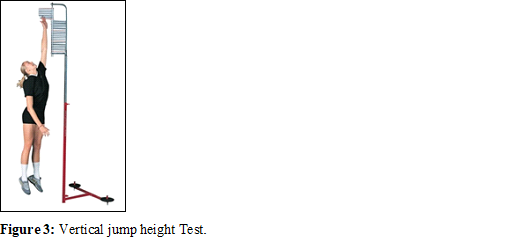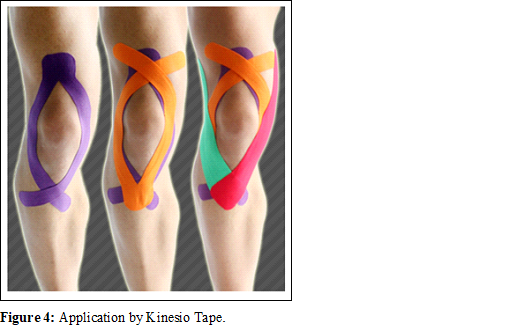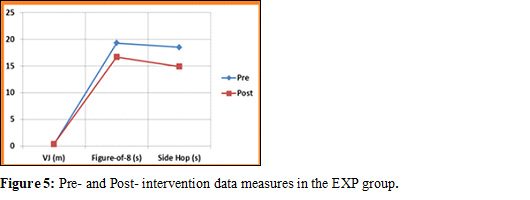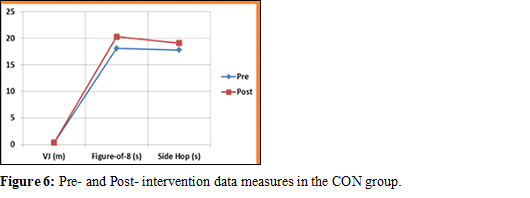Research - (2022) Volume 17, Issue 3
Effects Of Kinesio Taping On Functional Performance And Anterior Cruciate Ligament Rupture In Juvenile Female Soccer Pla
Ahmed Fadhil Farhan1*, Ismael Saleem Abed2 and Israa Gameel Housien3*Correspondence: Ahmed Fadhil Farhan, College of physical Education and Sport Sciences, AL-Ayen University, Al-Nasiriya-64001, Thi-Qar, Iraq, Email:
Abstract
The incidences rates of Anterior Cruciate Ligament (ACL) the highest in sports, especially among juvenile female soccer players, and a common method for decreasing pain, improve muscle function, circulation and proprioception is using kinesiotaping (KT). To determine the effects of using KT on functional performance (FP) of juvenile soccer players with (ACL) injuries. Twenty-three juvenile female soccer players (Age13.31 ± 0.25 years; Stature 1.49 ± 0.18m; BMI 21.3 ± 2.24 kg/m2) participants in this study. Twelve participants with mild (ACL) injuries in the experimental group (EXP), and (11) player with no history of (ACL) injuries in the control group (CON). KT was applied once and maintained for three consecutive days on (EXP) group. Participants performed three functional tests (Vertical jumping heights, Shape of 8 hop test and Shape side hop test) with and without the knee taped. The ANOVA (one-way) test with repeated measures and independent t-tests was applied, considering a 5% significance level. There was a significant between-group difference at each time point after KT application (p<0.05), with lower pain in the kinesiotaping. Pair wise comparison of the outcome measures in the two occasions (without KT and with KT) revealed statistically significant differences in all FP test (p<0.05). There was a significant between-group difference after application in the KT group (p < 0.05). The KT has superior effect in juvenile female soccer players with mild (ACL) injuries and can be used safely for improving knee joint stability and FP.
Keywords
Soccer players. ACL injuries. Kinesio taping. Juvenile female
Introduction
Soccer injuries are among the highest in sports for both males and females when considering 1,000 hours of the game. [1] “Stated that epidemiology studies on the occurrence rates of soccer injuries among young players are relatively rare and difficult to compare”. Increased risk of injury is associated with internal factors including the level of talent, strength, sport-specific techniques and postural stability [2].The ACL injuries are most common injuries among young male and female soccer player. The (ACL) has usually exposes to persistent pressure for long term that could be taken many years however, individual differences among young male and female soccer is consideration [3]. Much of the attention has focused on the seemingly higher injury rates in young female soccer as compared to elite male soccer [4]. The significance of anatomical position of ACL which is deeply lied in center of knee among other ligaments as well proximally articulated with femur bone and distally with tibia bone. Its function mainly to control straight up and rotating movement between tibia and femur moreover, restrict torsion movement of tibia. Basically, ACT injury may happen due to drop from high jump or accident attachment with opposite player that would be result in damage of this ligament and painful sensation in knee. Its worthy mention, the main role of ACT is providing stability of the knee. The frequent occurrence of injury of knee is necessary to shed light on creating new prevention programs to support knee joint [5]. Previous studies have been using certain devices for external knee stabilization to increase performance in lower-extremity function nevertheless that was not adequate as convenient results [6-7]. Utilizing of conventional knee stabilizers to elevate functional performance is still controversial. Consequently, Kinesiotaping application is regarding novel taping technique to support knee stabilization. Kinesio Tape (KT) is explored by Kenzo Kase, a Japanese chiropractor in 1980 and has widely used in clinical applications. KT is made from of polymer elastic strand mixed with pure cotton fibers moreover its thickness is comparable to epidermis that would be gain high evaporation and dry in moisture effected area of body [8]. Also, it characteristics with pure acrylic as adhesive properties that will act on activating body heat more further, can safely use for few days without complications [9]. There are some factors associated to high injury incidence among young soccer players, as previous study mention that high rates of injuries among juvenile female attributed to apply fault techniques in training and using hazard equipment [10]. Further reason of high injury occurrence are application not suitable equipment and technique, poor coaching and r training [11-12]. In view of the lack understanding among young adolescents on the importance of being physically fit, it may also lead to increase certain injury in many joints. Therefore, the aim of current study is to reveal the influence of KT in functional performance on ACL injuries in juvenile female soccer players.
Materials and Methods
2.1 Participants
Twenty-three juvenile female soccer players (Age13.31 ± 0.25 years; Stature 1.49 ± 0.18 m; BMI 21.3 ± 2.24 kg/m2) participants in this study. Twelve participants with (ACL) mild injuries in the experimental group (EXP), and (11) participants without of (ACL) injuries in the control group (CON). KT was applied once and maintained for three consecutive days on (EXP) group. Participants performed three functional tests (Vertical jumping heights, Shape of 8 hop test and Shape side hop test) with and without the knee taped. All players in the EXP and CON groups received oral and written information about the study aims, in addition provided with written consent to participation in the study.
2.2 Physical Tests
Players in both groups performed a 5-minute warm-up then completed 3 functional performance tests (Shape of 8 hop test, Shape side hop test and Vertical jumping heights test), Figures 1, 2, 3. The time for (Shape of 8 hop test and Shape side hop test) recording by electronic timer. All participants performed up to three practice trials of each test to familiar with the testing procedures, and then followed by three trials at maxims effort. The players take rest for at least one minute between each individual trial.
2.2.1 Shape of 8 Test
The Shape of 8 hop test, a (5) m course outlined by cones was used (Figure 1). Each player was instructed to hop on one limb, two times around the course as faster as possible. Players perform 3 trials with approximately five minute recovery between each course. Player, who fell, did not complete the course or missed the stopwatch pad, asked to perform the trial again [13]. The reliability, (ICC) of the test is very highs (ICC = 0.95).
2.2.2 Shape Side Hop Test
The Shape side hop test, all players were instructed to hop on one limb laterally over a (30) cm distance course (Figure 2). One course constitute hop on one laterally (30) cm and back to the start line. Each player was instructed to complete (10) times as faster as possible. If player fell, miss stopwatch pad, not complete the (30) cm hopping the trial, asked to perform the trial again [14]. The reliability, (ICC) of the test is very highs (ICC = 0.84).
2.2.3 Vertical jump height Test
The Vertical Jump Height (VJH) was measured by maxims double-leg jump with arm swing (Figure 3). Players position they feet approximately with shoulder width before attempting the jump. The VJH was determined to the nearest (0.1) cm. Players perform 3 jump trials with approximately one minute recovery between each jumps. The reliability, (ICC) of the test is very highs (ICC = 0.97).
2.3 Using of Kinesio Tape
Examination has been performed for baseline study voluntaries, participants were divided into two groups; first, KT group as experimental group (EXP)) and second, free-KT group as control group (CON)). Participants in EXP group were subjected to tape application by Kinesio Tape Tex with tension, while participants in CON group stay without taping. Taping procedure has been done under physiotherapist supervision who was regularly utilizing KT in the clinical work. The tape was just laid on skin of participants in EXP group. Kinesio Tex® Tape has different properties such as porous, waterproof, and adhesive. Participants in EXP group have been educated that they were subjected to exercise and take shower with the tape on. The dimensions of KT were 5 cm in width and 0.5 mm in thickness. KT application has been done according to instructions Kenzo Kase’s Kinesio taping manual. All participants in EXP group have been taped knee sprain in lateral and medial surfaces. One long Y-strip and the other one small Y- strip were involved in Techniques of KT. The participants in EXP group were seated position with the knee flexed. The long Y- strip, first strip was applied in the middle of thigh. Remove the backing to the end of the tails, and applied the tails around either side of the patella with 25-50% tension. Small Y-strip (second strip) was laterally used in patella. Remove the backing to the end of the tails, and applied the tails above and below the patella with 50% tension. Applied the anchors of the tail ends with no tension on the medial side of the patella (Figure 4). Rub the kinesiology tape down onto the skin to ensure optimum adhesion. The KT was applied once and maintained for three consecutive days (Figures 5 and 6).
3 Statistical Analysis (SPSS)
The statistical analysis was performed with software package (SPSS v19, Chicago, US). Tables were used for described categorical data, frequency and means + SD calculated for all measures. The repeated measures ANOVA (one-way) using to compere between groups. The statistical significance was set at (p≤ 0.05).
Results
The results showed no changes in body mass or stature in both groups at baseline characteristics when analyzing the results of 23 female young soccer players participated in this study (Table 1). Means and + SD for all tests are showed in the (Table 2). Measures of leg power (VJH) increased significantly [6.7±1.5% (p < 0.05), Table 2] in EXP, but not CON group [-0.7±0.3% (p > 0.05), Table 2]. Whilst there was improve in EXP for both Shape of 8 and Shape side hop tests to [-1.3±0.2% and -1.7±1.5% (p < 0.05) respectively, Table 2], no significant in the CON group for both Shape of 8 and Shape side hop tests [1.5±1.8% and 1.8±0.5% (p > 0.05) respectively, Table 2] when compared with EXP group. 5 Discussion
| Characteristics | Experimental (N=12) | Control (N=11) | P-value |
|---|---|---|---|
| Age (yrs) | 13.52±0.27 | 13.63±0.82 | 0.92 ns |
| Height (m) | 1.62±0.42 | 1.64±0.98 | 0.85 ns |
| BMI (Kg/m2) | 21.82±0.79 | 22.05±021 | 0.72 ns |
| ns (non- significant): p > 0.05; Data are presented as mean ± SD | |||
| Tests | Experimental (n=12) | %â?³ | Control (n=11) | %â?³ | P-value | ||
|---|---|---|---|---|---|---|---|
| Pre | Post | Pre | Post | ||||
| VJ(m) | 0.37±0.25 | 0.39±0.43 | 6.7±1.5 | 0.35±1.05 | 0.35±0.9 | -0.7±0.3 | 0.003 |
| Figure-of-8 (s) | 20.1±4.21 | 17.7±0.15 | -1.3±0.2 | 19.07±5.2 | 20.51±0.8 | 1.5±1.8 | 0.007 |
| Side Hop (s) | 19.76±0.2 | 15.5±0.19 | -1.7±1.5 | 18.30±0.2 | 19.09±1.2 | 1.8±0.5 | 0.009 |
| â?³= change.P value reflects differences between the change scores for each group; Significant: p > 0.05; Data are presented as mean ± SD | |||||||
Discussion
Several studies have demonstrated the action of KT in supporting functional performance and reduce injuries especially, in muscles, ligament and tendon [15]. It has been explained role of KT in many protocols of rehabilitation as well as in prevention of athletes injuries throughout healthcare field application particularly, physical therapists and athletic trainers [16]. However, KT efficacy is still not approved in prevention ACL injuries among juvenile female soccer player. Meanwhile few studies have been shown that KT application in mitigating pain symptoms in clinical approaches [15-17]. In addition, some trials have been applied KT to demonstrate its efficacy in pain reduction via randomized double-blinded. However these trials need more evidence. The purpose of this study was to investigate the effect of KT on FP of juvenile female soccer players with ACL. The high improvement was showed for (VJH) height (EXP = 6.2 ± 4.1 %; CON = -0.2 ± 0.4%, p < 0.05, Figures 5, 6). In soccer, leg power muscles would likely be associated with improved jumping and sprinting ability on the field [18-20]. However, it may also serve to decrease the risk of knee, ankle and other lower limb extremity injuries [21]. The results of this study were consistent with results of the most recent study done by [22] that showed increased explosive power with KT application. While not consistent with previous study that showed no difference in the VJH height for players with KT application [23]. This corresponds to the previous study in which they showed no significant increase of muscle peak torque 10 minutes after tape application, but increased torque after 24 hours of KT application [24]. That was corresponding to previous study that mention the challenges of application of this type of tape in tension due to muscle fibers direction that would be result in muscles strength [25]. The knee flexion of angle impacts ACL loading through its relationships with tendon-tibia of patella shaft angle and ACL elevate angle [26-27]. Studies showed that ACL loading decreased when knee flexion angles increased [82, 27]. In the present study, KT application resulted in improved figure-of-8 leg power (EXP = -1.7 ±4.5%, p < 0.05; CON = 1.5 ±3.2%, p > 0.05, Figures 5, 6) and side hop leg power (EXP = -1.8 ±9.8%, p < 0.05; CON = 1.6 ±5.3%, p > 0.05, Figures 5, 6). In both EXP and CON groups the different initial conditions of this result might be attributed. In addition, that could be attributed to KT application induced increase extension of isokinetic knee peak torque and distance of single leg hop. Many authors referring to this type of tape and bracing improved proprioceptive activity because stimulation increased in cutaneous mechanoreceptors [29]. However, results of the findings vary, with some studies showing improved proprioceptive activity [30]. While others showed no change or worse activity with tape and brace [31-32]. Present study was applied tape once and keeps on 72 hours. The results of this study clearly indicated that the ACL of soccer injuries in juvenile female players can be reduced by a KT application. The greatest effects were observed for mild injuries incurred during training. The findings in this study indicated a statistical significance on FP of juvenile female soccer players with mild ACL injuries.
Conclusion
In conclusion, current study confirmed that ACL injuries could be relief by using KT in juvenile female who are suffering from this type of injury. The results showed significant improvement in FP in short time after using KT, meanwhile there is no significant improvement has been observed in soccer players who are not applying KT. In addition, it has been shown that KT application was high efficacy in increasing single leg hop distance as well as improving isokinetic knee extension peak torque. This study recommended for further researches to explain gender differences that related to use of this type of taping.
References
D'Hooghe, P., Wiegerinck, J., Tol, J., & Landreau, P. (2013). A 22-year-old professional soccer player with atraumatic ankle pain. bjsports-2013-092579a.
Fong DT, Hong Y, Chan LK, et al. A systematicreview on ankle injury and ankle sprain in sports. Sports Med. 2007; 37(1):73–94.
Farhan AF, Saleh HS, Redin RA. Effectiveness of sport drink on the physical performance on junior male soccer players. Journal of Advanced Biomedical &Pathobiology Research.2015;5(3)32-41.
Farhan AF. Appropriateness of FIFA,s “The 11” Prevention Training Program for Juvenile Soccer Players-Effects on Physical Performance. International Journal of Advanced Sport Sciences Reasearch. 2013;1(3)244-252
Johnson GB. Athletic taping and bandaging. In: Safran MR, McKeag DB, Van Camp, eds. Manual of Sports Medicine. Philadelphia, PA: Lippincott-Raven; 1998: 635-638.
Metcalfe RC, Schlabach GA, Looney MA, et al. A comparison of moleskintape, linentape, and lace-up brace on joint restriction and movement performance. J Athl Train. 1997; 32(2):136–140.
Cordova ML, Scott BD, Ingersoll CD, LeBlanc MJ. Effect of ankle support on lower-extremity functional performance: a metaanalysis. Med Sci Sports Exert. 2005; 37(4): 635-641.
Gonzalez-Iglesias J, Fernandez-De-Las-Penas C, Cleland J, Huijbregts P, Gutierrez-Vega MD. Short-Term effects of cervical kinesio taping on pain and cervical range of motion in patients with acute whiplash injury: A randomized clinical trial. J Orthop Sports Phys. 2009; 39(7): 515-521.
Kase K, Wallis J, Kase T. Clinical therapeuticapplications of the Kinesio taping method. 2nd ed. Albuquerque, NM: Kinesio Taping Association; 2003.
Faigenbaum, A. D., Kraemer, W. J., Blimkie, C. J., Jeffreys, I., Micheli, L. J., Nitka, M., & Rowland, T. W. (2009). Youth resistance training: updated position statement paper from the national strength and conditioning association. The Journal of Strength & Conditioning Research, 23, S60-S79.
Kruse, D., & Lemmen, B. (2009). Spine injuries in the sport of gymnastics. Current sports medicine reports, 8(1), 20-28.
Skoffer, B., & Foldspang, A. (2008). Physical activity and low-back pain in schoolchildren. European Spine Journal, 17(3), 373-379.
Docherty CL, Arnold BL, Gansneder BM, Hurwitz S, Gieck J. Functional-performance deficits in volunteers with functional ankle instability. J Athl Train. 2005;40:30-34.
Itoh H, Kurosaka M, Yoshiya S, Ichihashi N, Mizuno K. Evaluation of functional deficits determined by four different hop tests in patients with anterior cruciate ligament deficiency. Knee Surg Sports Traumatol Arthrosc. 1998;6:241-245.
Thelen MD, Dauber JA, Stoneman PD. Clinical effi cacy of kinesio tape for shoulder pain: A randomized double-blinded, clinical trial. J Orthop Sport Phys. 2008; 38(7): 389-395.
Kaya E. Zinnuroglu M, Tugcu I. Kinesio taping compared to physical therapy modalities for the treatment of shoulder impingement syndrome. Clin Rheumatol. 2011; 30(2): 201-207.
Saavedra-Hernandez M, Castro-Sánchez AM, Arroyo- Morales M, Cleland JA, Lara-Palomo IC, Fernandez- De-Las-Penas C. Short-term effects of kinesio taping versus cervical thrust manipulation in patients with mechanical neck pain: A randomized clinical trial. J Orthop Sport Phys. 2012; 42(8): 724-730.
Farhan AF, Stephany MJ, Mahammed SK. Effect of training program on physical performance in junior male Malaysian soccer players. Journal of Physical Education and Sport. 2013; 13(2), 238-243.
Shakir HS, Farhan AF, Saleh H. Impaction of tocotrienol rich fraction palm oil in aging and recreational athletes. International Journal of Advanced Sport Sciences Reasearch. 2013;1(2)174-180.
Shamil WK, Farhan AF. The Relationship between some Physical Abilities and some Biomechanical Variables with the Shooting Accuracy in Football. International Journal of Advanced Sport Sciences Reasearch. 2013;1(2)190-200.
Farhan AF, Stephany MJ, Mahammed SK. Prevention of Soccer-Related Ankle Injuries in Youth Amateur Players: A Randomized Controlled Trial. Movement, Health & Exercise.2017; 6(1): 39-45.
Mostert-Wentzel K, Swart JJ, Masenyetse LJ, Sihlali BH et al. Effect of kinesio taping on explosive muscle power of gluteus maximus of male athletes. Afr J SM. 2012; 24(3): 75-80.
Aktas G, Baltaci G. Does Kinesiotaping increase knee muscles strength and functional performance? Isokinet Exerc Sci. 2011; 19: 149-155.
Slupik A, Dwornik M, Bialoszewski D, Zych E. Effect of Kinesio Taping on bioelectrical activity of vastus medialis muscle. Preliminary report. Ortop Traumatol Rehabil 2007; 9(6): 644-651.
Morrissey D. Proprioceptive shoulder taping. J Bodywork Movement Ther, 2000; 4:189-94.
Li G, Defrate LE, Rubash HE, Gill TJ. In vivo kinematics of the ACL during weight-bearing knee flexion. J Orthop Res 2005;23:340e4.
Lin CF, Gross M, Ji C, Padua D, Weinhold P, Garrett WE, et al. A stochastic biomechanical model for risk and risk factors of non-contact anterior cruciate ligament injuries. J Biomech 2009;42:418e23.
Markolf KL, Burchfield DM, Shapiro MM, Shepard MF, Finerman GA, Slauterbeck JL. Combined knee loading states that generate high anterior cruciate ligament forces. J Orthop Res 1995;13:930e5.
Feuerbach JW, Grabiner MD, Koh TJ, et al. Effect of an ankle orthosis and ankle ligament anesthesia on ankle joint proprioception. Am J Sports Med. 1994; 22(2): 223–229.
Jerosch J, Hoffstetter I, Bork H, et al. The infl uence of orthoses on the proprioception of the ankle joint. Knee Surg Sports Traumatol Arthrosc. 1995; 3(1):39–46.
Refshauge KM, Kilbreath SL, Raymond J. The effect of recurrent ankle inversion sprain and taping on proprioception at the ankle. Med Sci Sports Exerc.2000; 32(1):10–15.
Refshauge KM, Raymond J, Kilbreath SL, et al. The effect of ankle taping on detection of inversion–eversion movements in participants with recurrent ankle sprain. Am J Sports Med. 2009; 37(2):371–375.




